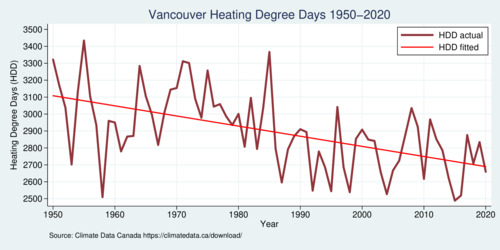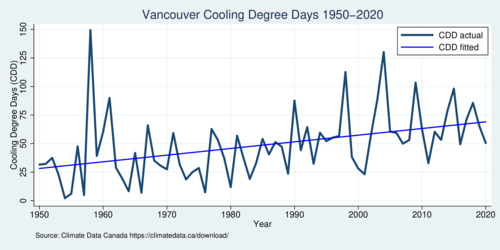A cold spell in Texas left an estimated 4.5 million households out of power on February 16, and with millions still out of power as I write these lines. As The New York Times reported wind farms aren't the main cause of the Texas blackouts, the main contributing factors were freezing natural gas pipelines. And as The Economist reported, the freeze in Texas exposed America's infrastructural failings. The higher occurrence of extreme cold and extreme hot temperatures has been linked to climate change. Could it happen here in Vancouver as well? Extreme cold in Canada is not unusual. The infamous 1998 ice storm knocked out power lines in Quebec and eastern Ontario, leaving roughly half of Quebec's population without power.
Weather in Vancouver is pretty mild and even the coldest winter days tend to be pretty balmy by Canadian standards. Have winters and summers become warmer in Vancouver? Let's look at the weather evidence over a long timer period, the 70 years from 1950 to 2020. This is sufficient long to capture effects of climate chanage.
The need for heating in the winter is captured by a measure known as Heating Degree Days (HDD). It is a measure of how cold the temperature was on a given day or during a period of days, and is calculated as the difference between 18°C and the coldest temperature of a day. For example, a day with a mean temperature of 3°C has 15 HDD. Two such cold days in a row have a total of 30 HDD for the two-day period. The measure that captures hot days is known as Cooling Degree Days (CDD). It is measured as the difference between the highest temperature of a day and 18°C.
The diagram below shows the HDDs for Vancouver over the last 70 years, with a trend line showing a clear movement downwards. I estimate that Vancouver has 5.98 HDDs fewer every year, statistically significant at the 99.9% confidence level.

click on image for high-resolution PDF version
The next diagram shows the CDDs for Vancouver over the last 70 years, with a trend line showing a clear movement upward. I estimate that Vancouver has 0.58 CDDs more every year, again statistically significant at the 99.9% confidence level.

click on image for high-resolution PDF version
So as Vancouver's winter are getting milder and its summers are getting gently warmer, this is good news for our electricity grid. BC Hydro will experience fewer winters that put high demand on the system. On the other hand, air conditioning in the summer can be expected to rise. In terms of electricity demand, British Columbia will remain a winter-peaking jurisdiction for quite some time. Vancouver's summers are never extremely hot, in most years never exceeding 30°C.
Yet, all infrastructure is vulnerable to extreme events. Power lines are vulnerable to inclement weather, in particular ice that weighs down the lines. BC's specific vulnerability lies in its dependence on a few major north-south power lines. If any of these get knocked out in the winter, the lights could even go out in Vancouver. Making the electricity grid more resilient is a task for this decade. Two researchers at the Rocky Mountain Institute, Mark Dyson and Becky Li, authored a report Reimagining Grid Resilience for the United States. The challenge is to avoid cascading failures, and have greater redundancy in the system through distributing critical loads and functions. Anotherreport from 2013 Improving Electric Grid Reliabiity and Resililence from The GridWise Alliance looks at the aftermath of superstorm Sandy and makes a list of insightful recommendations. Hardening the infrastructure also requires making the electric grid more of an information system with better sensors and management systems. Improving the resilience of our electricity grid ultimately rests on four essential areas: (1) better software to detect, isolate, and restore problems; (2) hardening critical compoents against adverse events; (3) distributing generation and distribution to limit the scope of failures; and (4) allowing for critical demand response when all else fails.
Related blogs
- How much more electricity does B.C. use when it gets cold?, January 31, 2020.
- Electricity demand in British Columbia, January 26, 2020.
![[Sauder School of Business]](logo-ubc-sauder-2016.png)
![[The University of British Columbia]](logo-ubc-2016.png)